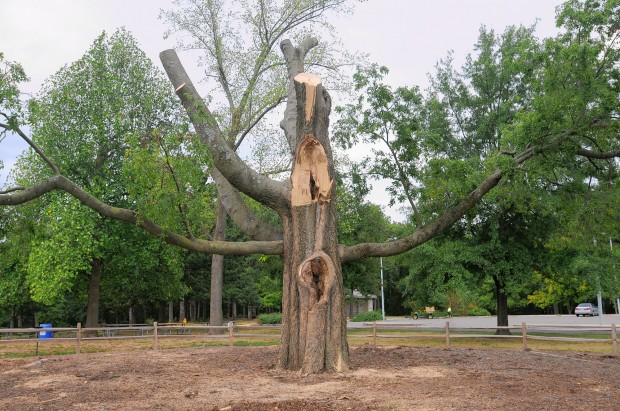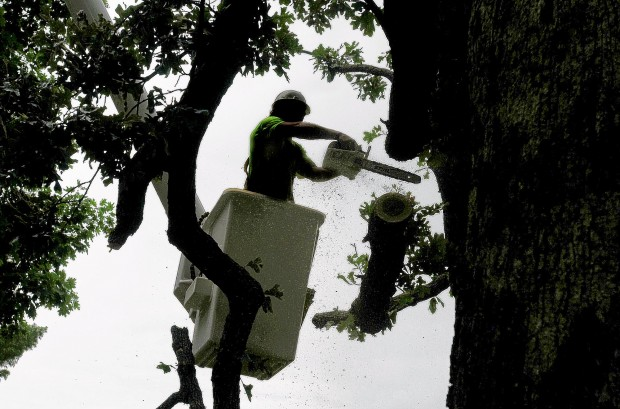Drought and heat wave killing shade trees across Missouri – ‘Paper-dry to the core’
By Sarah Baraba
24 July 2012 The iconic 145-foot Sugarberry Tree in Kirkwood Park has weathered a lighting strike, rotor wash from a Marine helicopter and more than 150 years of unpredictable St. Louis weather, but the recent heat wave was the last straw in its battle to survive. Just as the sun was rising above the Missouri State Champion tree on July 6, a large portion of the tree gave way. “It broke around 6:20 in the morning with no wind,” said Curt Carron, Kirkwood Parks superintendent. “It was paper dry to the core.” The tree will be removed later this year.
Across the region, trees are similarly parched given this summer’s heat and drought. As of last week, St. Louis County as well as more than 93 percent of Missouri was in a ‘severe” drought, according to the National Climatic Data Center. Just over 23 percent of the state was in an “extreme” drought. Recent cloud cover may have dropped sporadic showers across the region, but public works directors say it’s not enough to quench trees’ thirst, particularly those in city rights-of-way and parking lots. In Sunset Hills, public works director Anne Lamitola said the city removed five large trees earlier this month in the rights-of-way. Some had diameters as wide as two-and-a-half feet.
“Our code compliance officer is working with numerous property owners who have dead trees on their private property,” she said in an email. “A dead tree becomes ‘hazardous’ when that tree can fall on a structure or into a public right-of-way.” Young trees in Chesterfield can be seen wearing a unique accessory. Several of the trees with trunks less than six inches in diameter are wearing “gator bags,” or bags of water seated at a tree’s base that slowly water roots. “Trees like a long, slow soak,” explained Mindy Mohrman, city arborist for Chesterfield. “They’re not cheap, so we just use them on the trees that are the highest priority.” Maryland Heights is taking similar precautions. “Younger trees don’t have root systems deep enough to survive on their own in this kind of drought,” said Bryan Pearl, Maryland Heights public works director. Trees less than a year old are getting supplemental water, he said. […] Though the region has seen long-lasting heat in past summers, the seasons leading up to summer have usually provided enough rain or snowfall to build up saturation in the soil. “This past winter was dry too, we only had one snowfall. So there’s no moisture to begin with. If the ground is so dry, where are the roots going to find moisture?” said Gary Blassie, St. Louis County Parks forestry supervisor. Pine trees, dogwoods and even native Missouri perennial flowers have taken the hardest hit, he said. […]


of course the drought is very bad. But trees have sustained very bad droughts in the past. The difference this time is tropospheric ozone that is killing trees everywhere on the planet. Here in Montreal, Canada, all the trees are dying. See Wit's end blog for all the facts. (tropospheric ozone is never addressed because it is intimately linked to fossil fuels and the gods of our times: cars and planes)